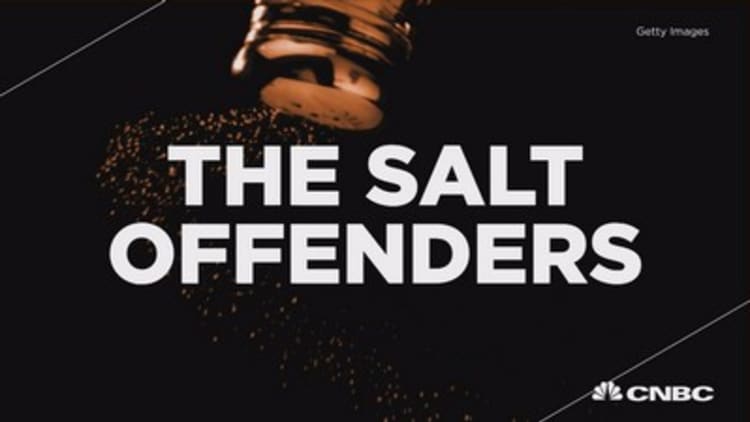
The restaurant world has seen several high-profile nutrition announcements lately: everything from pledging to ditch artificial ingredients at Panera and Taco Bell to getting rid of GMO items at Chipotle.
But there has been less fanfare in the sodium department. In fact, a recent report found restaurants just haven't been able to shake the salt.
That could change, however, as New York City officials put the topic of sodium back on the table with proposed changes to its health code.

From 2012 to 2014, "there was almost no reduction in the average sodium content across all menu items" analyzed at the nation's biggest 25 restaurant chains, according to the nonprofit Center for Science in the Public Interest, which used data from the New York City Department of Health and Mental Hygiene.
That data has its limitations and does not include every single item at each restaurant, but it underscores an important finding: Sodium levels of a wide swath of dishes are on the high side.
Sodium is not budging
The average sodium of all items among the biggest chains in 2014 was 1,256 milligrams, down just 1 percent from 2012's level of 1,267 milligrams. Several chains, including Applebee's, Chili's, IHOP and Olive Garden, had mean sodium levels last year that hit 1,500 mg or more, the recommended level for roughly half of high-risk Americans.
Considering U.S. dietary guidelines call for no more than 2,300 mg per day, these items pack quite a punch—especially for customers who frequent restaurants multiple times per day. The numbers are even starker for at-risk groups—people who are 51 and older, black or have high blood pressure, diabetes or chronic kidney disease. These groups should limit sodium to 1,500 mg per day, according to U.S. Dietary Guidelines.
"Despite the voluntary commitments by the food industry to reduce sodium on their own, this analysis shows a stunning lack of overall progress in a significant sector of the industry. By no measure was there sustained, across-the-board progress in reducing sodium in the menu items offered in these top 25 restaurants," according to the center's report.
New York wants to warn restaurant goers about how salty these items are since customers often do not do the legwork on their own. The city's health department is pushing for a change to its health code that would allow it to label items that exceed the daily recommended limit at chain restaurants.
The move could especially hit casual dining chains, which often deal mega sodium punches from entrees or shared appetizers—items like Chili's Southern Smokehouse Burger, which packs 4,470 mg of sodium, or Olive Garden's Seafood Alfredo dinner dish at 3,200 milligrams.
Individual fast food items are often lower but when calculated as combo meals, they often tip the sodium scales, too. For example, a McDonald's breakfast meal with a hashbrown; bacon, egg and cheese biscuit and small coffee contains 1,610 mg of sodium. At Hardee's, a half-pound Most American Thickburger and medium fries would tally 4,140 mg sodium.
The ongoing sodium squeeze
Several chains have vowed to cut back on sodium.
"We review our menu and nutrition criteria on an ongoing basis to ensure it is consistent with established scientific and government standards," wrote Burger King spokeswoman Alix Salyers in an email.
"As part of its commitment, BKC has successfully reduced the sodium content in many of its products around the world," she added.
Darden Restaurants has committed to reduce calories and sodium across its brands' menus by 10 percent by next year and by 20 percent by 2021.
"While I can't provide any figures, I can tell you we're making excellent strides toward our goal of reducing calories and sodium by 10 percent," said Darden Director of Communications Rich Jeffers.
Since 2008, Taco Bell has cut sodium by an average of 15 percent across its menu.
"Sodium reduction is an ongoing journey for us, and we'll continue to work with our suppliers and other industry experts who have already started their own sodium reduction overhaul processes and achieved success," wrote Missy Nelson, menu developer and registered dietitian at Taco Bell, in an email.
Meanwhile, Dunkin' Donuts has pledged to reduce its U.S. menu's sodium content by 10 percent by year end, a goal it first set in 2012. Sandwich chain Potbelly CEO and President Aylwin B. Lewis also reiterated its vow to tackle sodium reduction "over the next few years" during a May call with investors.
Boston Market also made a splash in 2012 when it got rid of tabletop salt shakes and vowed to slash sodium across its menu.


